Real leather does not peel nor flake. The only exception is if a leather’s urethane finish has been damaged. In this case, you’ll notice the grain and texture remain intact, and it’s easily corrected. See here.
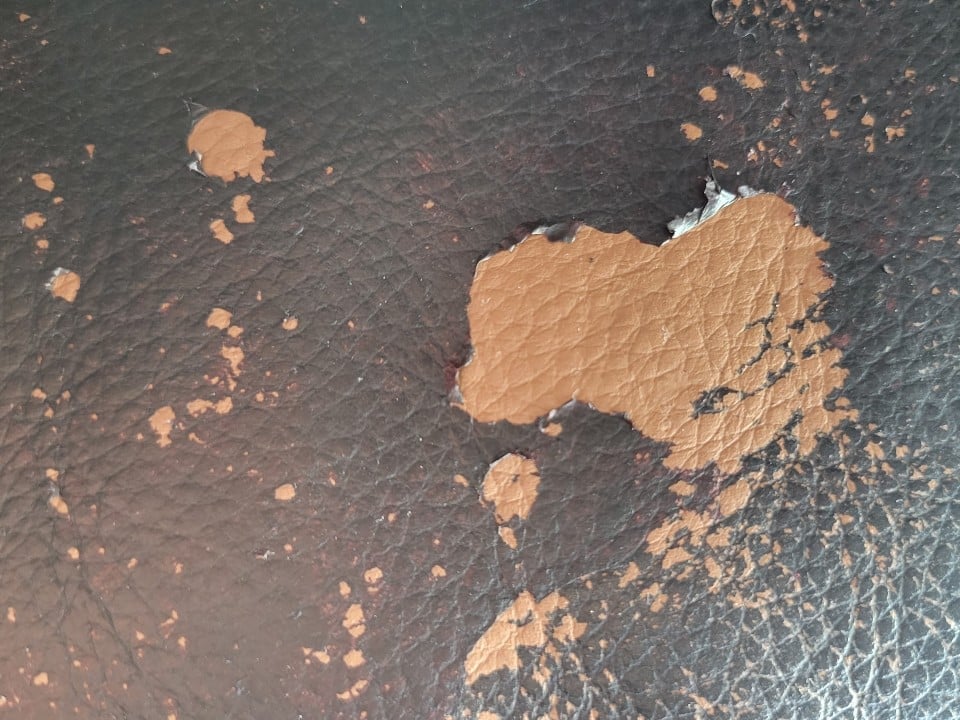
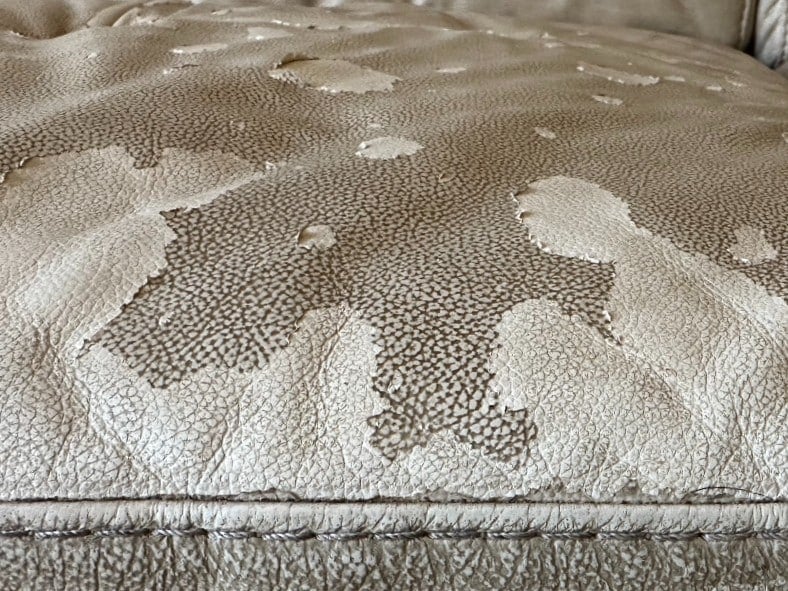
More often, peeling is a sign of fake leather whose polyurethane (PU) coating has begun to delaminate from the underlying fabric.
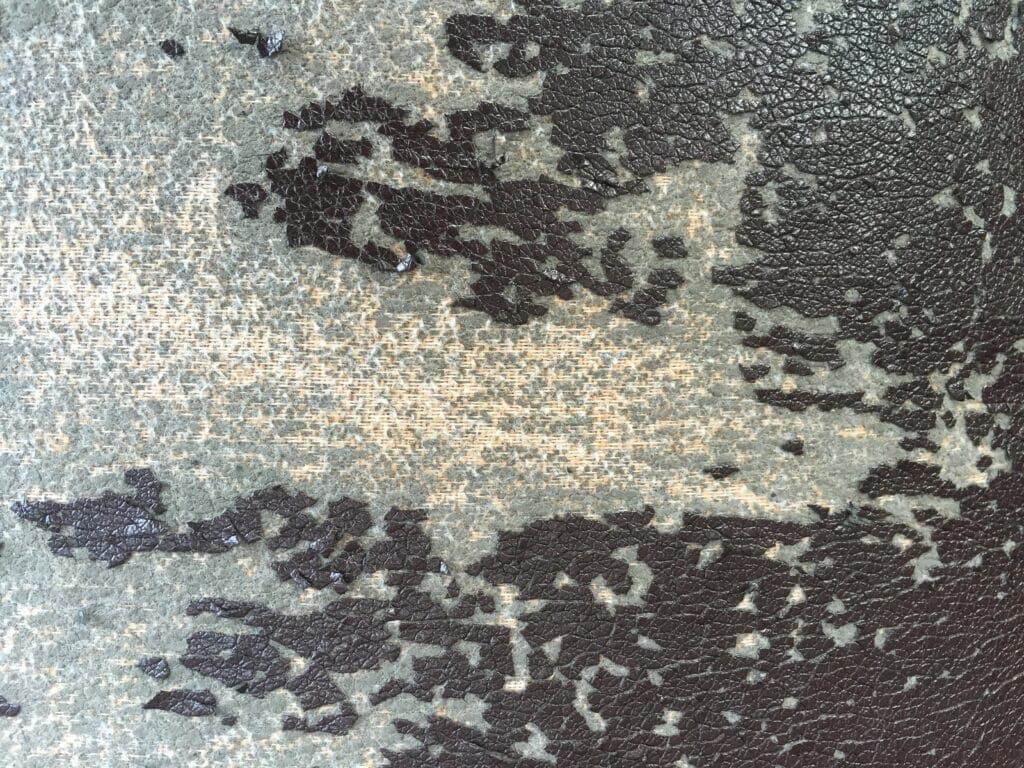
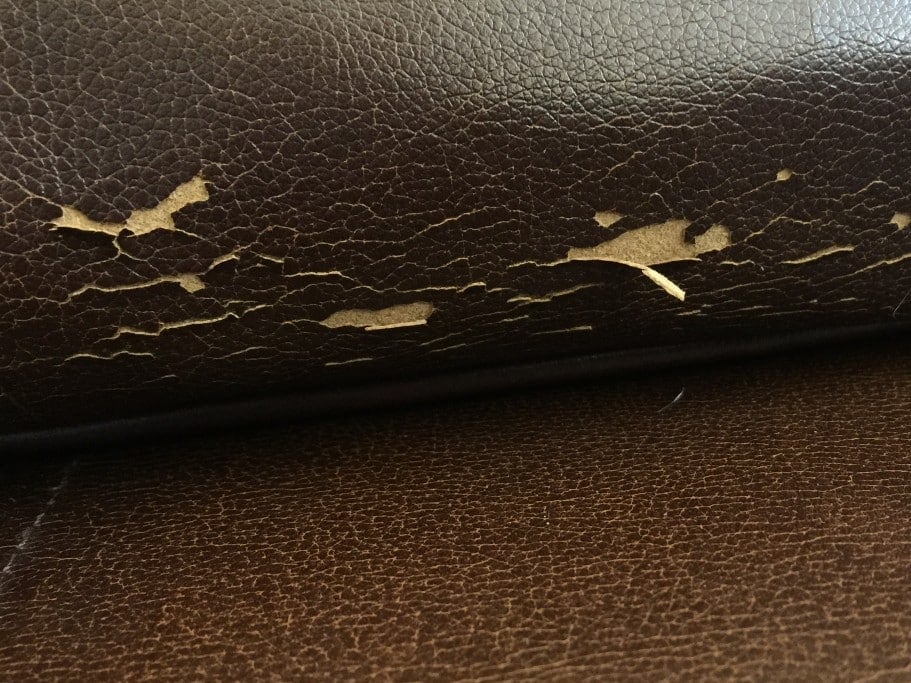
There’s nothing that can be done to prevent or protect it, and repairs seldom last.
Click here to jump ahead to the repair options.
What are bonded and faux leather?
Bonded leather (also called blended or reconstituted leather) is a composite material made of 10-20% ground scrap leather coated with a polyurethane ‘skin’. DuraBlend® and EnviroBlend® are US trademarked names for bonded leather.
Faux (the French word for ‘fake’) and vegan leather are rayon or polyester fabric coated with polyurethane ‘skin’. They are 100% synthetic. Ultraleather® is a trademarked brand of faux leather.
Polyurethane (PU) materials are the equivalent of cheap particle board and are not to be confused with better quality vinyl (PVC), which is widely used in boat, auto, and furniture upholstery.
Vinyl is very toxic to produce, however, which is why polyurethane-coated artificial leathers were developed in response.
Unfortunately, these polyurethane coatings often develop hairline cracks and delaminate in as little as 18 months — just as the warranty has expired. This is known as ‘hydrolysis-related failure’ by the industry and is specifically excluded from many warranty policies.
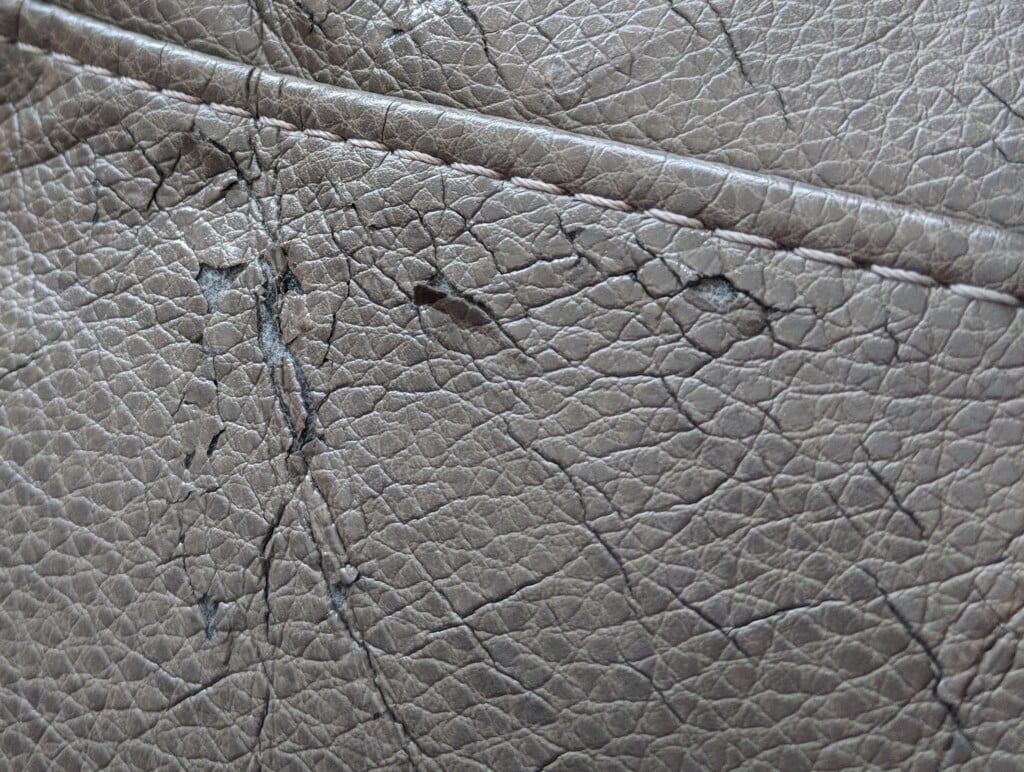
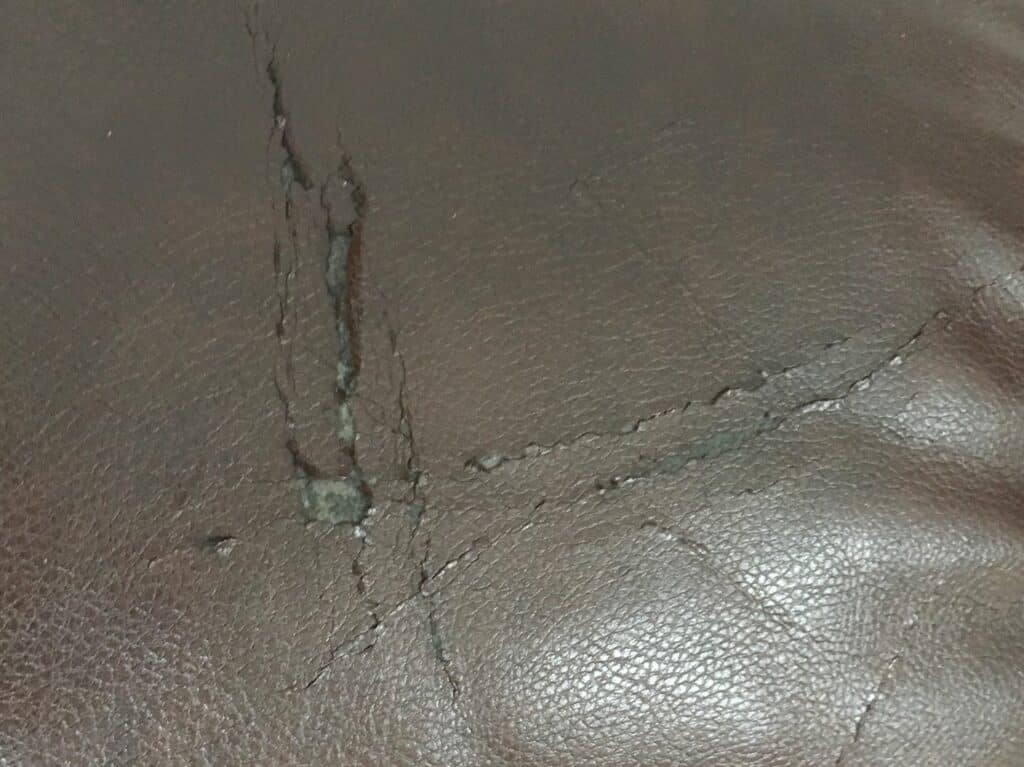
The industry uses ISO 1419 Tropical Test Method C (nicknamed the Jungle Test) to assess a material’s ‘hydrolysis resistance’, or rather, if and when a bonded or faux leather will crack, peel or delaminate in hot, humid conditions. The Association for Contract Textiles’ guideline recommends a minimum 5 week rating. “Note that there is no direct correlation of testing weeks to years of service in the field.” Even the best polyurethane resins for commercial use were never expected to last more than a few years.
What toxic pollution was spared by producing PU instead of PVC is neutered by its disposability and profusion in landfills.
Why are consumers misled about faux and bonded leather?
Most folks — consumers and salespeople alike — don’t know how to tell the difference between real and artificial leathers and often assume it’s real simply because ‘leather’ appears somewhere in the description. It wasn’t until 2017 that the term ‘leather’ came to be regulated in the United States.
Still, ignorance and affordability allow these inferior fake leathers to prevail.
Even at a wholesale price, top grain leather costs about $100 / yard. Full grain costs even more, and it takes many yards to upholster a piece of furniture:
- large club chair: 5-7 yards = $500-$700 leather cost
- 3-seat couch: 15-20 yards = $1,500-$2,000 leather cost
- 5 or 6-seat sectional: 30 yards = $3,000 leather cost
These 2023 figures don’t include other materials like the wood or metal frame, foam stuffing, the labor, let alone inflation. Do the math. If you paid $1,500-$2,000 for a new leather couch, it is likely fake.
There’s no product that can stop ‘leather’ from peeling.
The instability of bonded and faux leather means repair compounds and new coatings don’t adhere well. The video in option 2 below demonstrates how you’d repair it and the disappointing month-later result. We’re big fans of turning trash into treasure, but peeling bonded or faux leather is rarely worth the effort.
Ask yourself: do you want to spend time and money to improve its appearance, knowing such an improvement may be short-lived and likely a waste (option 1 and option 2)? Or would you rather invest a similar amount of time and money in a better-quality piece that will last years, even decades (option 3)?
Option 1: Stain the Fabric
Peel and scrape away as much of the unstable polyurethane ‘skin’ as possible, and stain the exposed fabric with one of our water-based paints.
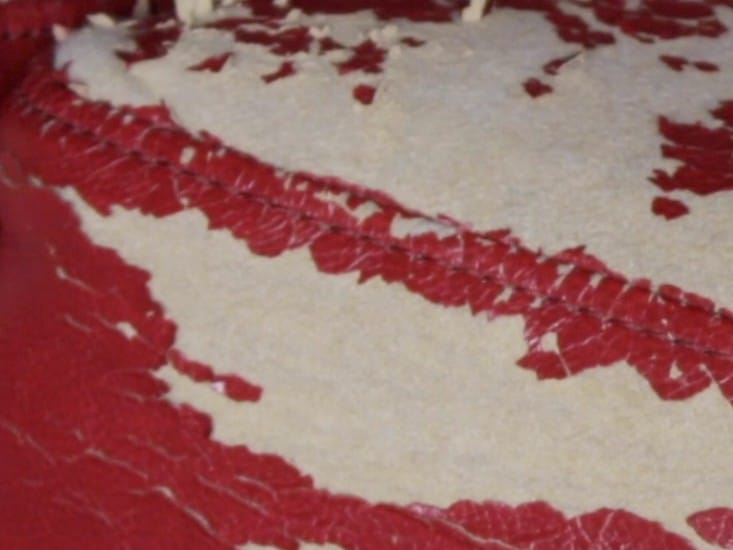
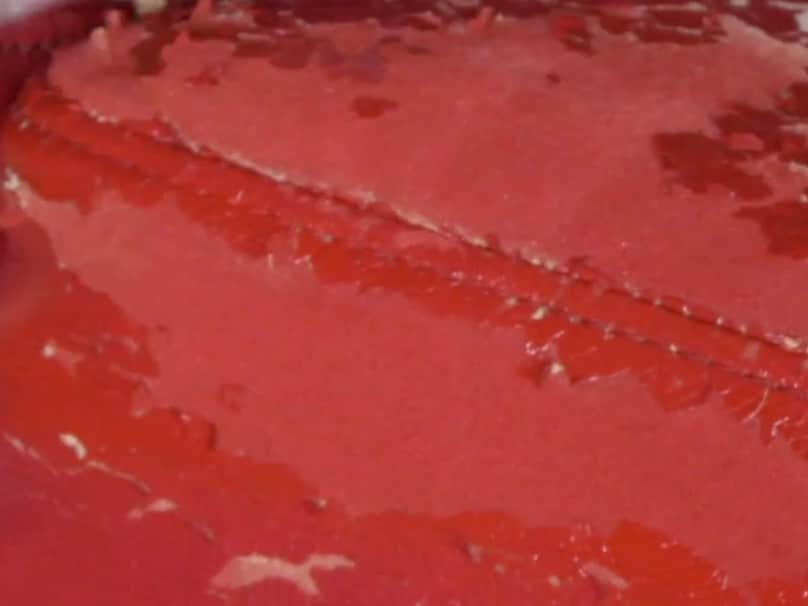
This improves appearance somewhat, but you will not have a smooth, lustrous leather-like surface that repels water, and the disparity in texture will be obvious from a 2-3 foot distance.
This option will take a couple hours and cost $23 – $50, depending on the scope of the damage. Note that the color will dry a little darker on the fabric than it will on the polyurethane or sample swatch, so you may want to choose a lighter shade or mix in another color to adjust it.
Option 2: Peel, Repair, Recolor
Resurface the exposed fabric using a leather filler putty or rubberized coating, followed by color, as demonstrated in the video below. You’ll spend several hours peeling, resurfacing, and recoloring. The cost will range from $41 to upwards of $100. There’s no guarantee the repairs will hold up, and the piece will continue to degrade elsewhere.
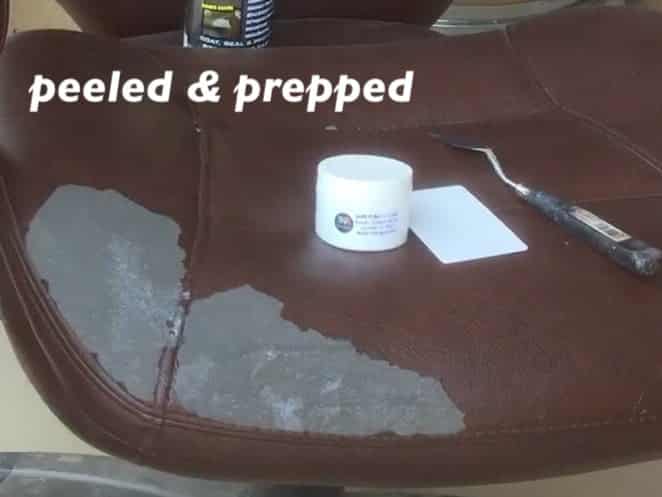
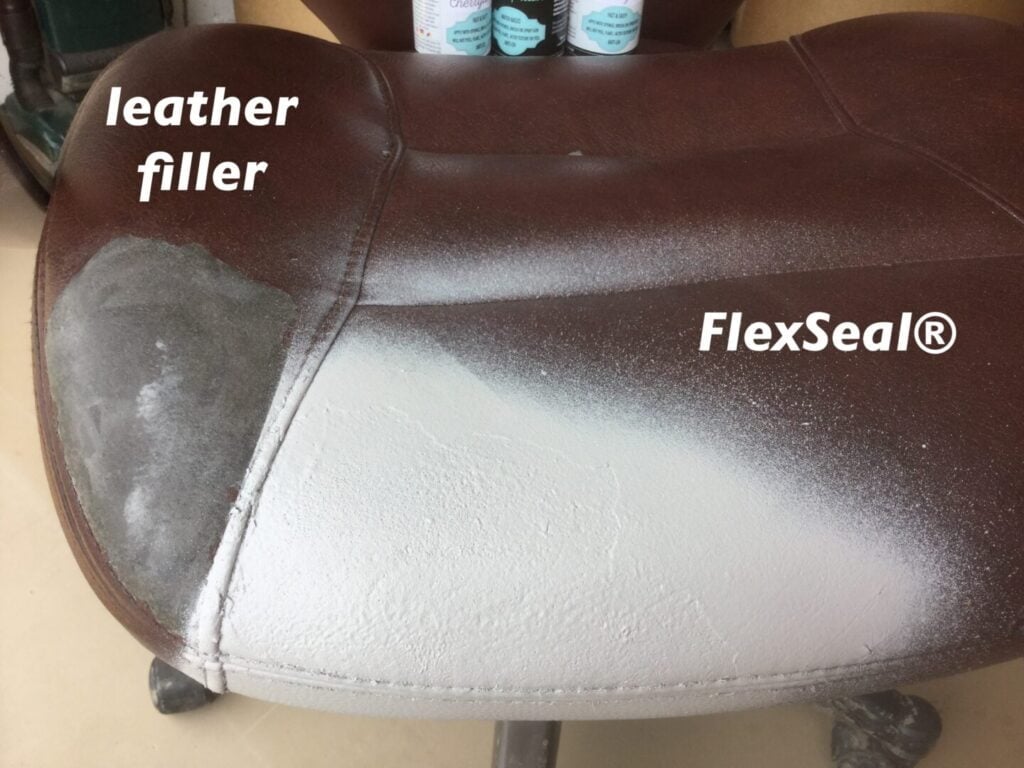
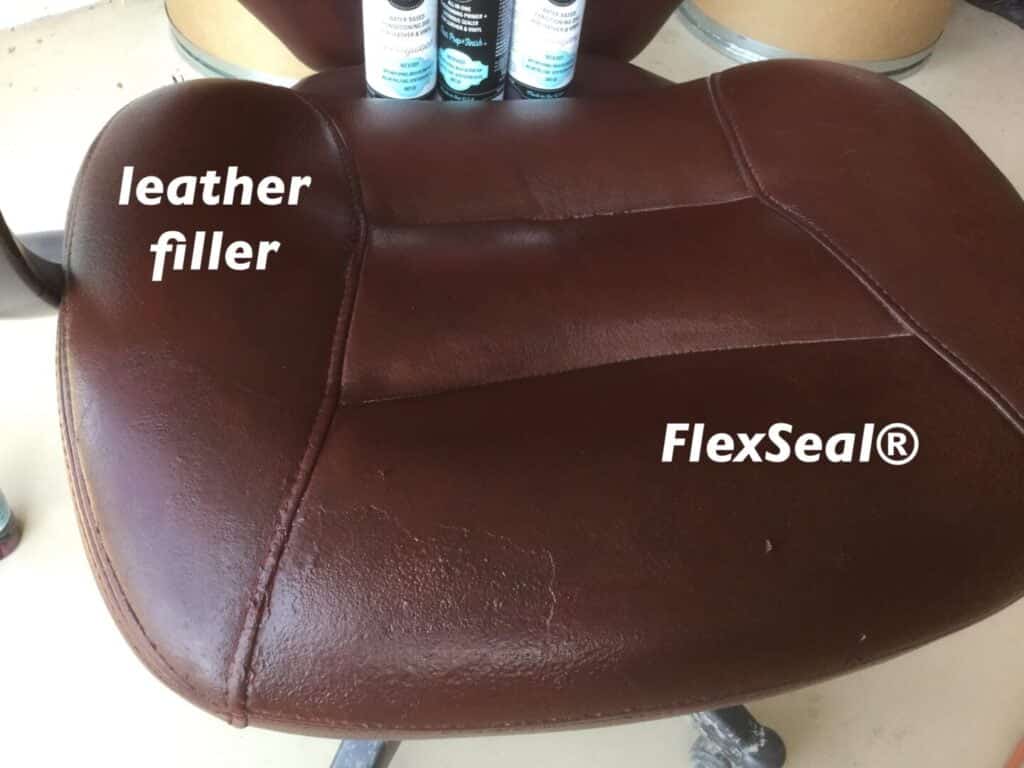
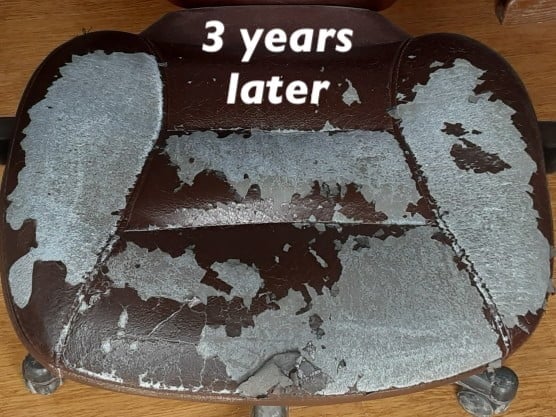
- 0:00 – Intro
- 0:28 – Prep peeling
- 0:57 – Applying Soft Filler leather repair putty
- 3:47 – Alas, more peeling
- 3:58 – Applying FlexSeal® rubber paint
- 5:13 – Comparing Soft Filler to FlexSeal®
- 5:45 – Recoloring
- 6:22 – The final result
- 6:40 – The verdict after a month of use
- 7:19 – Our recommendation
Option 3: Cut the Loss & Invest in Something Better
Replace the piece with real, good-quality leather. The restore it or even change the color. It’s amazing how many fine quality pieces can be found on Facebook Marketplace and Craigslist for just a couple hundreds dollars, if not for free. Don’t be afraid of stains, fading or even a hole. These are easily repaired with the same — if not less — effort than that of option 2. The cost may be as little as $23. Even if you need lots of repair materials and spring for color matching on a huge sectional, you won’t spend more than $250 – $300. Such an investment is worthy of a piece that cost several thousand dollars new and will last decades.
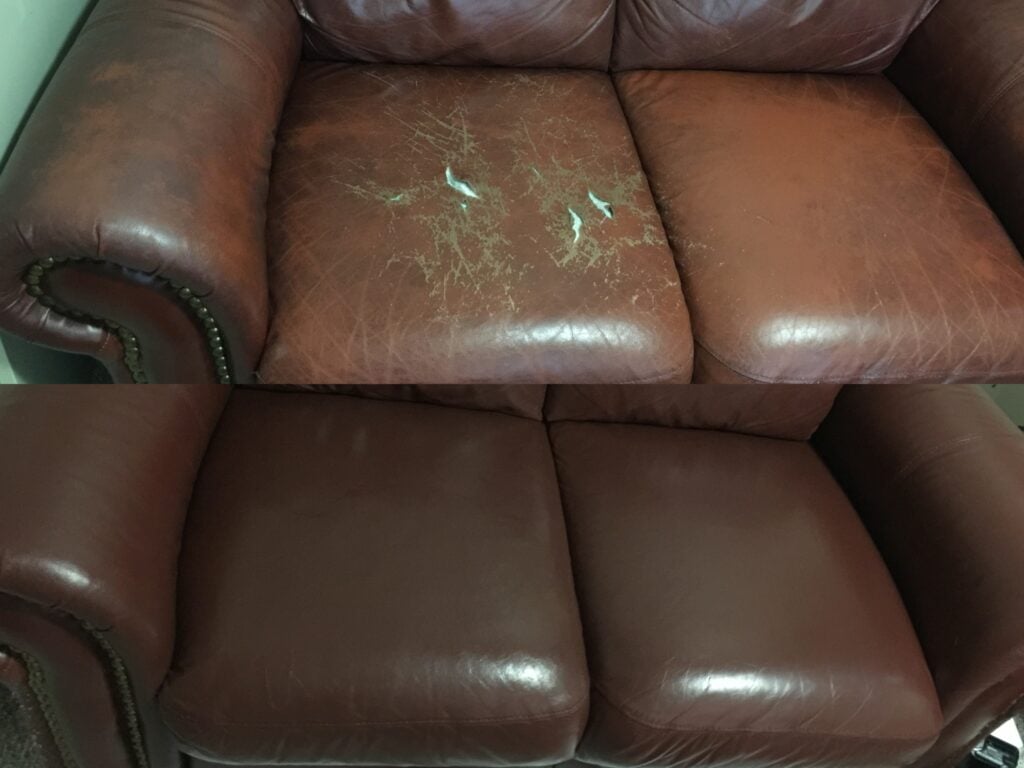

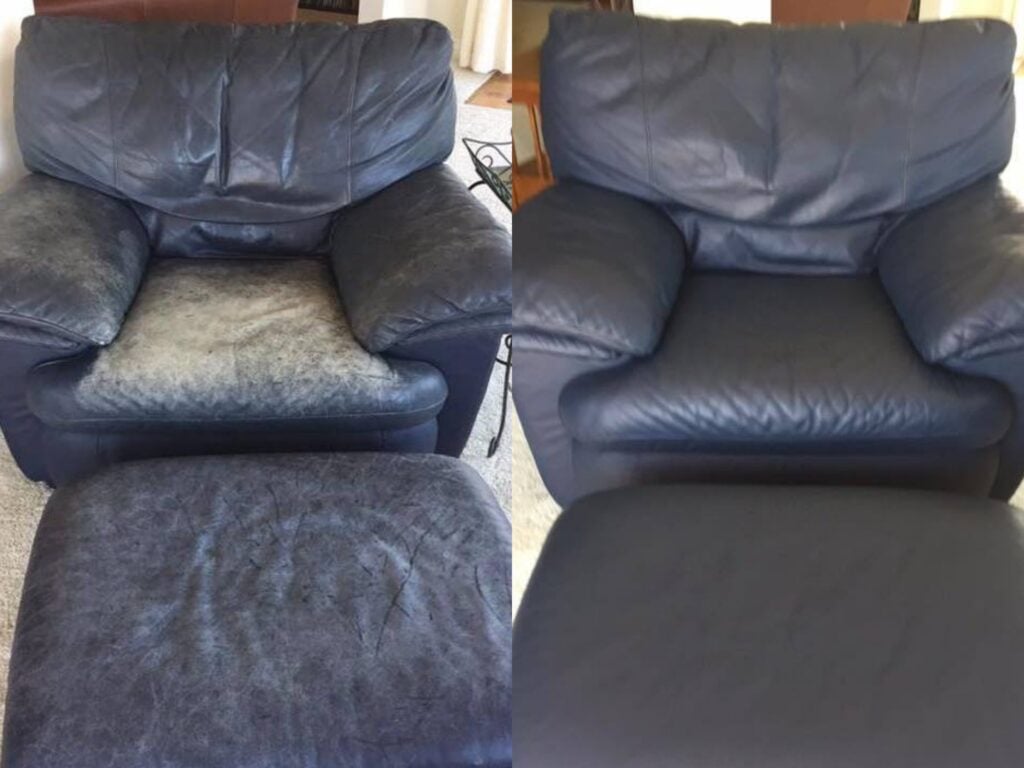
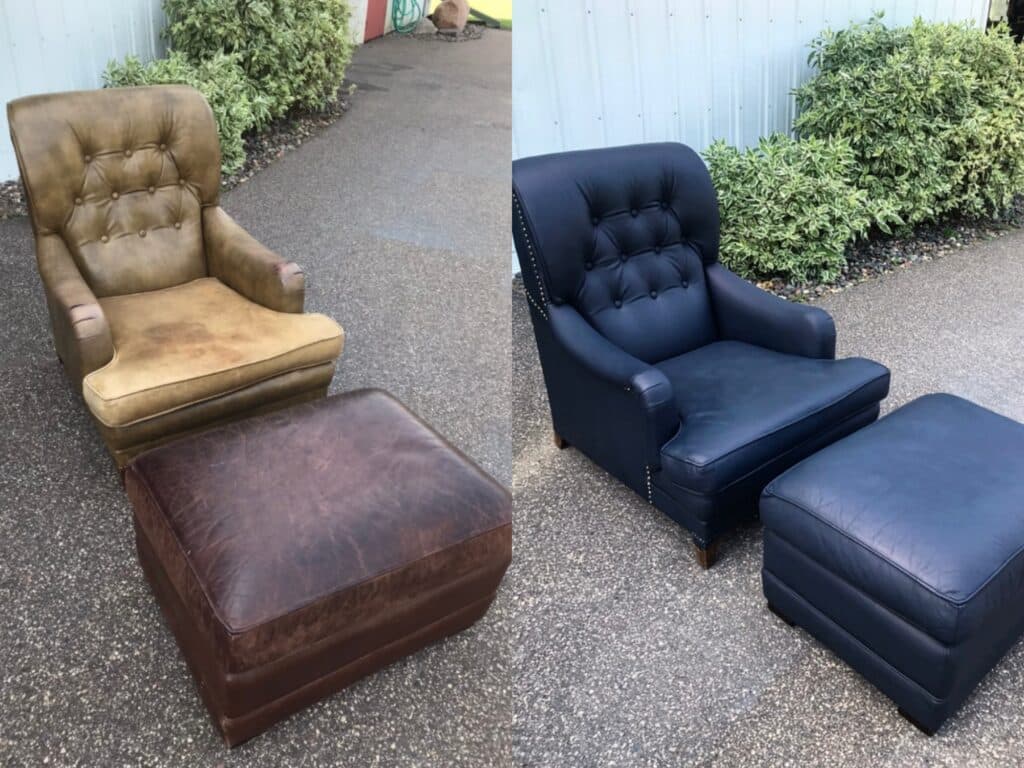
How To Spot The Finest Quality Leather
We love aniline and semi-aniline leather, which are among the best quality. These top grain or full grain leathers are dyed but have little or no clear finish, which makes them absorbent. This makes them susceptible to stains and sun fading, but it also means they can be found for cheap, often free.
Their absorbency also makes them the best candidate for a change of color, so even if you find one in the wrong shade, you can transform it to suit your décor.
Look for these features:
- Removable cushions – These require more yardage and labor. If the cushions unzip, the interior stuffing can be cleaned, plumped up or replaced. Note that most recliner chairs and sofas do not have removable cushions, but many are still a decent quality finished (non-absorbent) leather.
- Stains – Absorbent leathers with little or no clear finish will easily stain. Water marks, body oil, and pet stains may permanently stain leather, but they can usually be cleaned and concealed with a new color.
- Sun fading – Absorbent leathers often show severe and uneven fading. The dyes used in these leathers are not as UV resistant as synthetic materials, and it will be obvious.
- Marbling – Look for variation in color along with absorbency. Many fake and real leather will have a ‘base-and-print’ or two-tone appearance, but they will also repel water.
- Suede backing – The backside of the material (or areas exposed by cracks or tears) will be real suede, not microfiber or a woven fabric.
Don’t be deterred by cat scratches or a hole! These can be repaired.
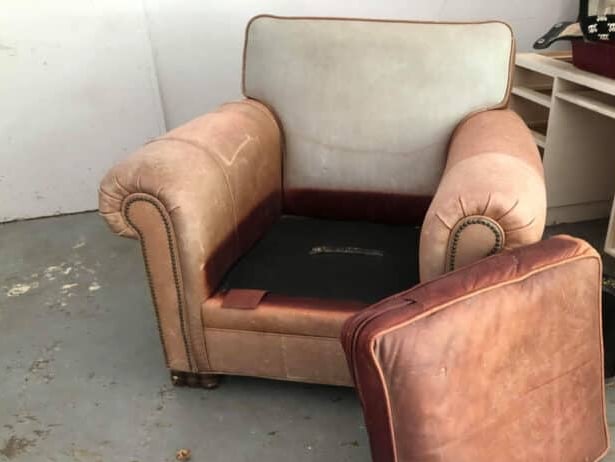
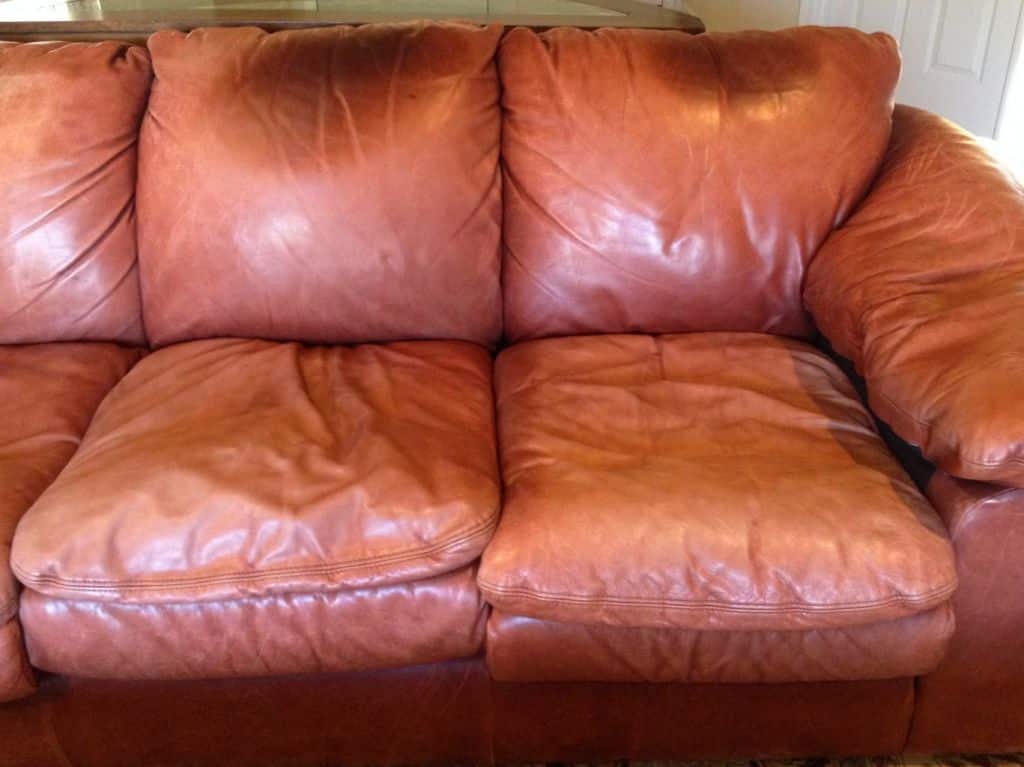
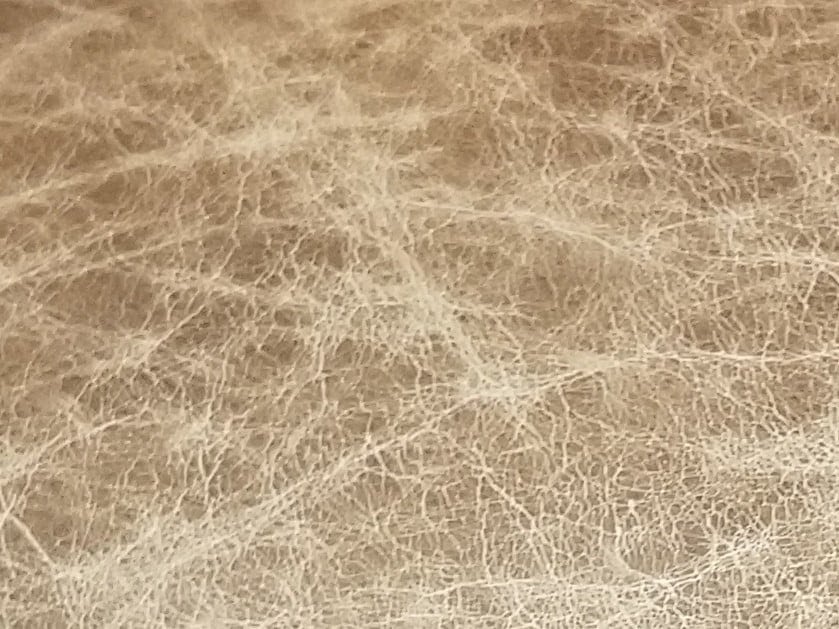
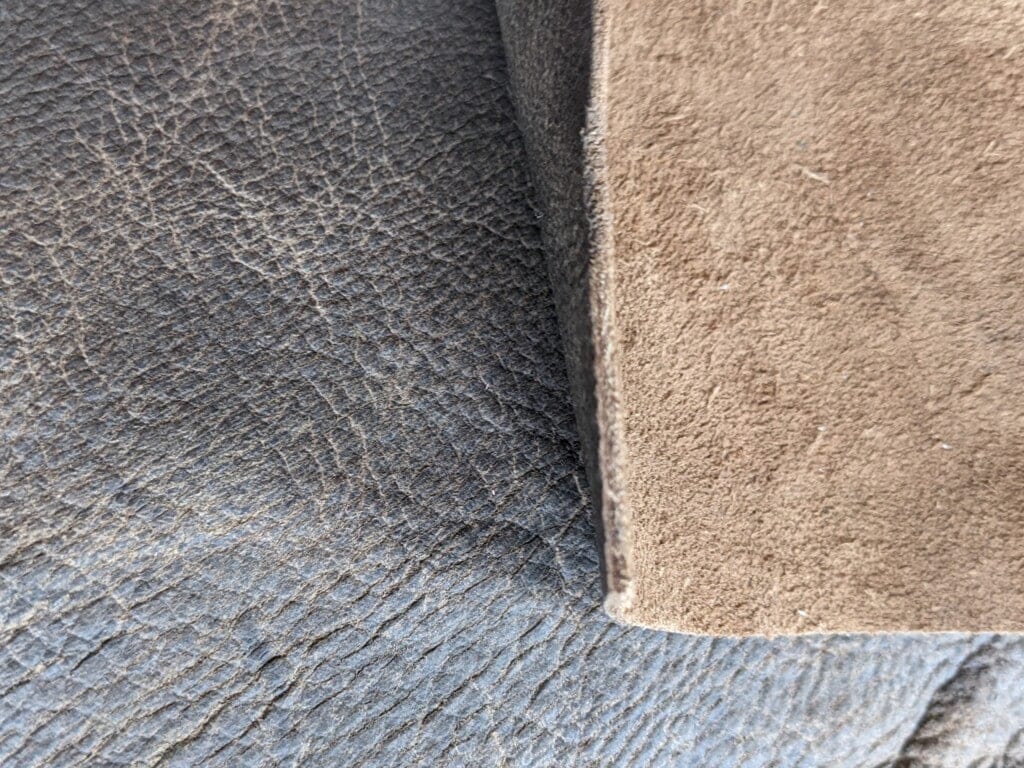
Also, don’t be fooled by some kinds of faux leather. As the smooth surface becomes worn, microfiber is exposed. It has a nap like real suede or carpet that can be brushed in any direction. These types of faux leather can be stained and coated with clear wax, but they are still poorer quality and not recommended.
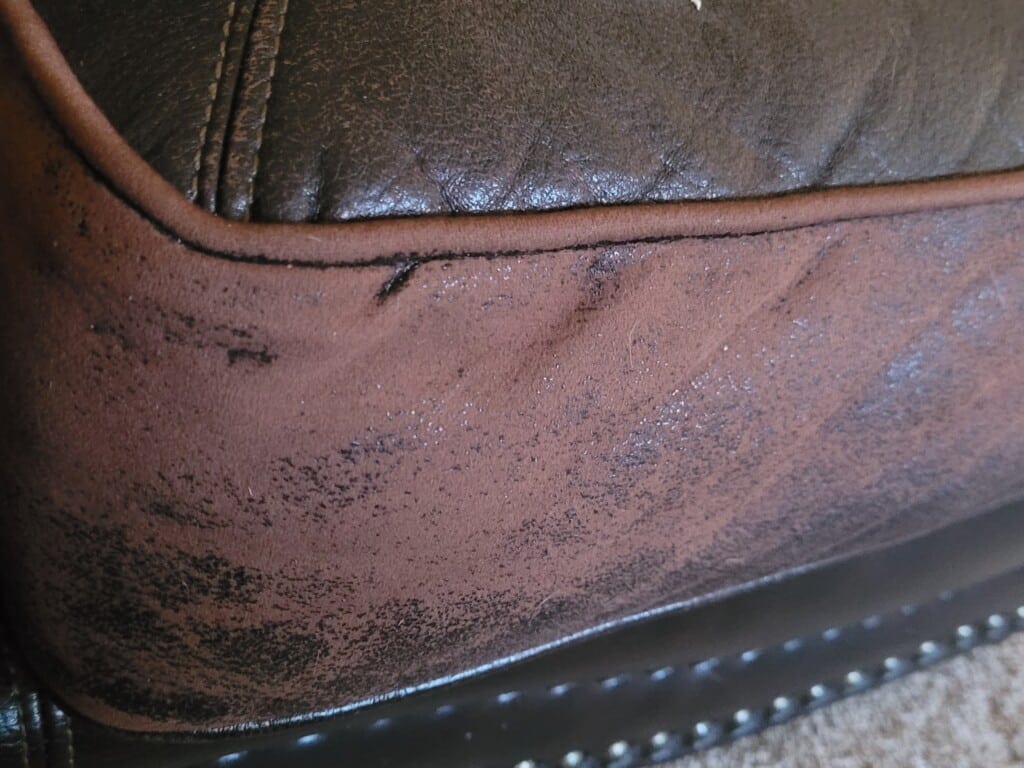
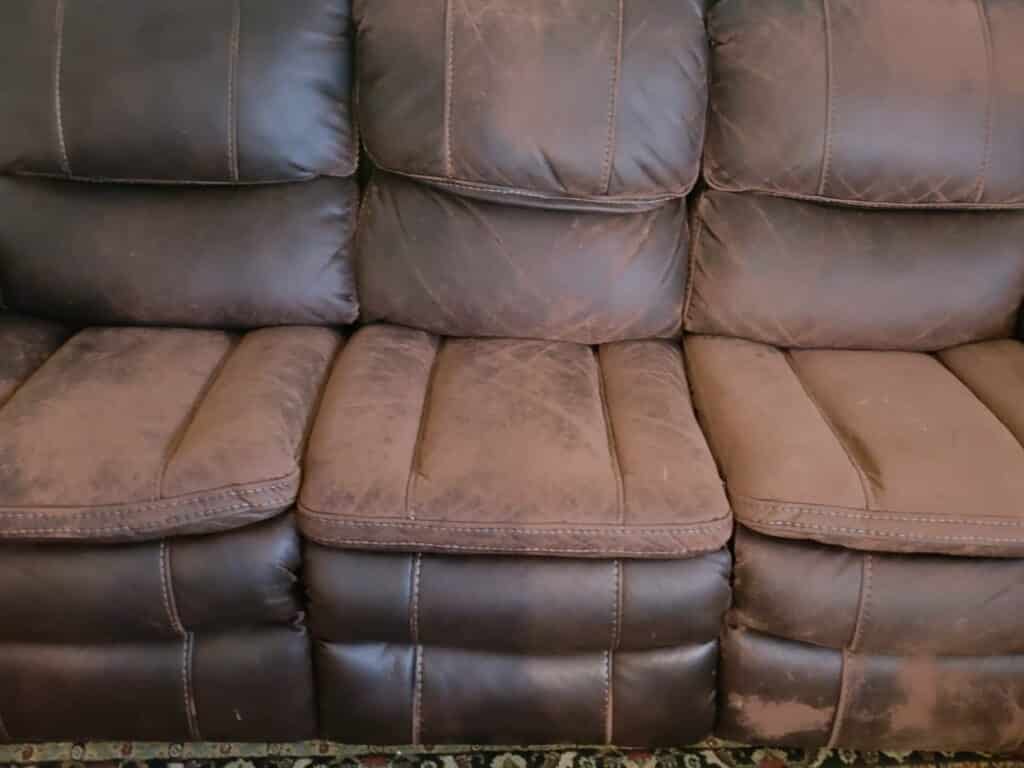
Learn more about the types of the leather as well as the differences between dyes and finishes.
If you need help, submit photos and request a consultation from the gal in the videos.
How will Rub n Restore work on bonded leather that has no peeling and a very solid unblemished surface? I would like to change a recliner sofa and loveseat from a very dark brown to more of a cognac color. Any advice will be appreciated.
Thanks
You could mail us a swatch for testing, but it is generally discouraged. Again, this material tends to delaminate from itself and even repair compounds do not adhere well, so neither will a finish
I really appreciate your honesty. I have been cruising around the interwebs trying to find a way to mitigate the eyesore in my living room that I was conned into purchasing at Nebraska Furniture Mart. It’s currently wearing a crappy cover that has to be adjusted constantly leading me to curse NFM daily but at least your site stopped me from throwing good money after bad. Thank you
How do you get the colors? We have a red lazy boy and a green lazy boy that we thot were leather. They are cracking and pitting and peeling after 2 years (paid $650 for each). I would be willing to try your method but wonder about the colors!
Many bonded leathers are dark brown, and our colors blend well, but red and green are primary-secondary colors and would require a custom match for an additional $60 per color. The other option is to recolor the entirety of each chair with our closest stock color, but this unfortunately is not recommended for bonded leather.
What are the differences with Bonded leather vs Leathertek? Can Leathertek be dyed color changed?
LeatherTek appears to be vinyl (PVC) not polyurethane (bonded leather), so it can be repaired or recolored. Please do read about color changing before proceeding.
I have a recliner that the seat, arm rest, foot rest and front upper back is leather. The sides and back are most likely vinyl. I wanted to change the color. Do you have a product that would do that?
Yes, please see this article and video about color changing leather or vinyl.
Great article, nice tips on how to repair peeling leather !
The arm of my chair started peeling only after my long-clawed granddog jumped up on it. The materials that came with the chair called it “100% leather” and the care instructions referred to it as “coated leather”. Is this still probably bonded leather or is there a distinction?
We’ve seen labels lie. But it could be a lousy coating on real leather. Can you see the grain? How to distinguish between real and peeling bonded leather here.
I cut a small piece off an inside flap on the side. I think it’s leather but I’ll send it in when I send the swatchees back and you can tell me. Thanks for your help!
Hi there. Ive got an eco white leather sofa and unfortunately the surface started to crack, looks like someone cut it in squared with a knife but jusy the surface and small square size pieces are peeling off. It was small but now it moved up the sofa on both ends. Is it worth to repair eco leather or should I buy new sofa? Thanks
Sounds like it’s only going to get worse. I’d scrape away and fabric paint (in which case you no longer have a ‘leather’ sofa) or replace as per the suggestion in the video and this article.
Thank you for sharing this video and advice. Extremely helpful. While I value your input I am going to attempt a repair as a short term fix while in transition to relocate. What products specifically do you recommend? I believe one is the flex filler but what do you purchase for the colour? Appreciate all your advice!
Our standard line of colors will conceal the repair but are unlikely to be an exact match. Please read about color matching options and services.
My sofa is peeling. Wat should I do ? Plz tell me fr it looks very very weird. Don’t want to change d sofa…
Hi I’m doing a diy attempt on my chili red couches I want to turn them a burnt orange color what all do I need from yo all
Greetings fellow Lesandra! We do not recommend color changing polyurethane leather. If it’s real leather or vinyl, our Rust or perhaps a mix of Cognac and Persimmon would come closest to the burnt orange color. Please read about color changing here. You can also submit an evaluation.
I am not sure what type of leather my couch is but I think it may be faux leather. It has been almost 5 years since we bought the couch and now the black color has faded to reddish brown color. The color has faded most in the areas where we sat the most. The skin is not peeling off but rather it seems like the black dots or patterns are coming off or flaking off and leaving it a reddish brown color. What do you think I should do?
Email info@rubnrestore.com a close-up photo of the worst area and broad shot of the couch, and we can be of more help.
Hi I recently picked up a leather sectional for my wife. It was supposed to be a great Mother’s Day gift. It’s pealing like crazy 😜 …. we have 2 young boys. It’s cafe/ expresso. I want to repair but not sure where to start.
You’re on the right page if you want to repair it. But with young boys, repair is going to be constant maintenance. You’re better off replacing it with real leather or quality vinyl. If you bought it new, I would return it and threaten suit if they refuse.
We have an almost 2 year old aniline-dyed and pigmented upholstered leather loveseat from IMG. The headrest just started peeling – can we fix or stop this?
If it’s real leather, then sanding or stripping will correct it.
After I sand or strip do I have to re coat it? If so with what ?
Appreciate you as manufacturer has yet to reply 😟
Yes you would definitely want to replace the finish that you sanded off. You’d want to color match the existing finish.
Great article! Especially liked your advise to look for aniline or semi-aniline leather- on point! Keep it up you guys!
Hi! Thank you for all of the advice. My couch is peeling pretty badly and I am planning to cover it with a slip cover. What would you recommend as the best method to stop the peeling? I don’t care how the finish looks, just don’t want the peeled off pieces to keep getting everywhere.
Thanks!
There is nothing that will stop the peeling except scraping it off completely to keep it from doing so.
My couch looks just like the couch at the very top (polyurethane coating worn off and now microfiber is all that’s left in most places.) What can I use ontop of the microfiber to get back that leather feel and protection?
A coat of Sherwin Williams high bond primer will give you the coverage and adherence you’re looking for to re-paint your peeling sofa.
Dude, did you even bother to read the article??
Watch the video.
Would love anyone’s help! I was very drawn to this vintage school library chair (underside has old stamp specifically stating it’s a Kerrville, Texas public school chair) and bought it thinking it was leather…eyeroll…not leather, of course. But whatever kind of synthetic faux leather it must be is very different than I’ve seen these days. No peeling, cracking, even has a natural sun faded look to parts of it. The “leather” material is just so thin I know it can’t be real. I want to update the chair with a modern twist and fix a few small knicks and scratches on it but how would I go about doing that if it’s not the modern day version of faux leather and def not real leather? I’m afraid since whatever kind of synthetic leather this may be is already around 65 years old, so definitely dont want to ruin it, because for being a senior this chair is still got it!
-thanks in advance:)
It’s likely some type of vinyl. We can be of help if you submit photos and answer some questions in the evaluation.
I have a faux leather sectional that has not peeled or cracked. I simply want to change the color. But I’m not sure if its a pvc or pu product and want to make sure your product will work. I would like to change the color to a medium gray.
You can either send a sample to us for free testing or you can test it yourself and return it if the material does not take it well. Apply a thin coat, let dry, repeat until covered. Then pinch, twist, stress. If it develops hairline cracks and looks like it will flake off, then it’s PU.
I have a similar situation with my sofa “Some faux leather furniture wears naturally, without peeling or flaking, and exposes an absorbent polyester or microfiber fabric that can be stained and waxed.”
How can I fix this? Please advise
we bought two sofas and they were described as being 100% high grain leather but clearly they are not because less than 2yrs later they are peeling and flaking and after reading all this article it would be a waste of time and money to even attempt a repair. Trades description act is what we are going to see a citizen’s advice about, these sofas are still available and still been advertised as real leather, wouldn’t have bought them if it had said faux/pu etc
Click the link about refinishing fabrics.
I already removed the PU fabric on my bar stools, would your product still have a longer life span than a month? What do you think would be the average.
Absolutely. Color will permanently stain the fabric, but you need to apply filler first to create the new leather-like surface. That should adhere well so long as it does not overlap any PU.